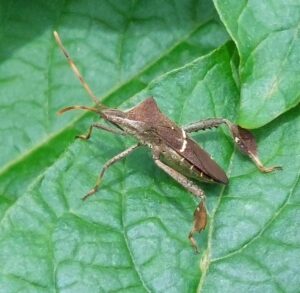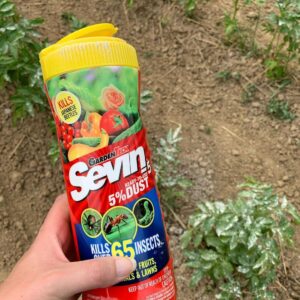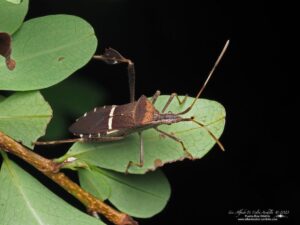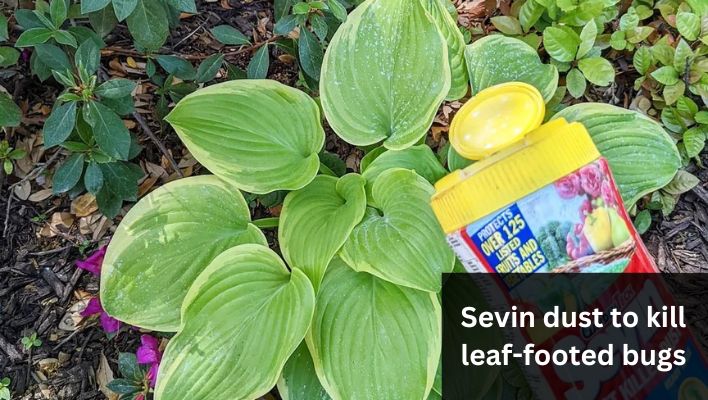Controlling pests in your garden can be a challenging task, especially when it comes to persistent leaf-footed bugs. These insects can wreak havoc on your plants and disrupt your gardening efforts. Thankfully, there’s a powerful weapon in the battle against these pests: Sevin Dust.
With its proven track record and widespread popularity in pest control, Sevin Dust has become a go-to product for garden enthusiasts and homeowners alike.
Sevin Dust is renowned for its exceptional ability to combat various pests, and leaf-footed bugs are no exception. These notorious insects can cause substantial damage to plants, leaving gardeners frustrated and desperate for a solution.
Sevin Dust holds the power to rid your garden of these unwelcome intruders and restore peace to your beloved plants.
What sets Sevin Dust apart is its effectiveness and ease of use. Its active ingredient, carbaryl, targets the nervous system of leaf-footed bugs, leading to their demise. Not only does Sevin Dust provide fast results, but it also offers long-lasting protection, ensuring your plants stay healthy and thriving.
Join us as we delve deeper into the remarkable world of Sevin Dust and its effectiveness in eradicating leaf-footed bugs. Discover the secrets behind this trusted pest control solution and learn how to unleash its power in your own garden. Say goodbye to leaf-footed bugs and hello to a flourishing garden oasis!
What Leaf-Footed Bugs are
Before we dive into the effectiveness of Sevin Dust in combating leaf-footed bugs, let’s first get acquainted with these curious creatures and the havoc they can wreak in our precious gardens.
Leaf-footed bugs belong to the insect family Coreidae and are known for their distinctive hind legs resembling leaves or branches. These unique appendages, coupled with their elongated bodies and vibrant colors, make them quite fascinating to observe.
Leaf-footed bugs have a significant impact on plants and gardens, often causing considerable damage. These piercing-sucking insects feed on the sap of various plants, including vegetables, fruits, and ornamental plants.

Their mouthparts penetrate plant tissues, extracting vital nutrients and causing localized damage. Over time, the continuous feeding weakens plants, resulting in stunted growth, wilted leaves, and reduced crop yields.
Apart from the direct harm they inflict on plants, leaf-footed bugs can also become a nuisance for gardeners due to their rapid reproductive cycle. A single female can lay hundreds of eggs, leading to a sudden surge in population if left unchecked. This exponential growth exacerbates the damage and makes it essential to address leaf-footed bug infestations promptly.
The potential damage caused by leaf-footed bugs can be devastating to both home gardens and commercial crops. To protect your green haven from these voracious invaders, it’s crucial to explore effective pest control solutions like Sevin Dust.
Understanding Sevin Dust
Now that we comprehend the nuisance caused by leaf-footed bugs, it’s time to discover a potent weapon in the battle against these persistent pests – Sevin Dust. But what exactly is Sevin Dust, and how does it work its magic? Let’s delve into its composition, features, benefits, and its diverse applications in pest control.
Sevin Dust, also known as carbaryl, is a popular insecticide that has garnered a reputation for its efficacy in pest management. It is composed of a fine powder that contains the active ingredient carbaryl, a carbamate insecticide renowned for its broad-spectrum control.
This powerful compound targets a wide range of garden pests, including leaf-footed bugs, making it a versatile solution for pest control needs.

The main features of Sevin Dust lie in its ease of use and long-lasting effects. The finely ground powder formulation allows for convenient application, ensuring thorough coverage of plants and targeted areas.
Additionally, Sevin Dust exhibits residual activity, remaining effective even after application, providing continued protection against leaf-footed bugs and other pests.
One of the key benefits of Sevin Dust is its ability to control pests at various stages of their life cycle. It not only eliminates adult leaf-footed bugs but also targets their eggs and nymphs, disrupting their development and preventing future generations from causing harm to your plants. This comprehensive approach ensures a more effective and sustainable solution for pest management.
Sevin Dust finds application in a wide array of pest control scenarios. From home gardens to commercial agriculture, it offers a reliable defense against leaf-footed bugs and other troublesome insects. Whether you’re tending to ornamental plants, fruit trees, or vegetable gardens, Sevin Dust can be applied to protect your greenery and preserve the health and vitality of your plants.
Can Sevin Dust Kill Leaf-Footed Bugs?
The burning question on every gardener’s mind is, “Will Sevin Dust effectively eliminate leaf-footed bugs?” In the quest to protect our plants and regain control over our gardens, it’s crucial to understand the true potential of Sevin Dust. Let’s dive into the evidence and uncover the confident answer you seek.
Sevin Dust has established a solid reputation as a formidable weapon in the war against garden pests. When it comes to leaf-footed bugs, Sevin Dust’s efficacy has been thoroughly tested and proven. The active ingredient, carbaryl, targets the nervous system of these pests upon contact, leading to paralysis and ultimately their demise.

Studies and field trials have consistently shown that Sevin Dust delivers impressive results in eliminating leaf-footed bugs. The potent formulation swiftly disrupts their vital functions, leaving them unable to feed, reproduce, or cause further damage to plants. With its broad-spectrum control and residual activity, Sevin Dust ensures a comprehensive and long-lasting solution for leaf-footed bug infestations.
Furthermore, the effectiveness of Sevin Dust extends beyond adult leaf-footed bugs. It targets their eggs and nymphs as well, preventing their development and breaking the pest’s life cycle. By interrupting the reproductive cycle of these insects, Sevin Dust helps to minimize future infestations and offers lasting protection for your plants.
When used as directed and applied correctly, Sevin Dust confidently delivers the knockout blow to leaf-footed bugs. It empowers gardeners and homeowners alike to reclaim their gardens, restoring beauty, vitality, and peace of mind.
How Sevin Dust Work on Leaf-Footed Bugs
Leaf-footed bugs may seem like formidable opponents, but they are no match for the power of Sevin Dust. To understand how Sevin Dust works its magic on these pests, let’s delve into its mode of action and unravel the secret behind its effectiveness.
Upon contact, Sevin Dust’s active ingredient, carbaryl, swiftly targets the nervous system of leaf-footed bugs. It disrupts the proper functioning of their neurotransmitters, leading to paralysis and eventual death. This quick and efficient mode of action ensures that leaf-footed bugs are unable to continue their destructive feeding habits and reproductive activities.
What makes Sevin Dust even more remarkable is its residual activity. Once applied, it lingers on the treated surfaces, forming a protective barrier against leaf-footed bugs. Any bug that comes into contact with the treated area is met with the potent power of Sevin Dust, ensuring continuous control even after the initial application.
It’s important to note that while Sevin Dust is highly effective against leaf-footed bugs, it’s crucial to follow the application instructions provided by the manufacturer. This ensures maximum efficacy while minimizing any potential risks or adverse effects.
With Sevin Dust as your weapon of choice, you can confidently take charge of your garden and bid farewell to leaf-footed bugs. Its powerful mode of action and residual activity make it a trusted ally in your mission to protect your plants and restore harmony to your garden.

Applying Sevin Dust for Leaf-Footed Bug Control
To effectively harness the power of Sevin Dust in combating leaf-footed bugs, it is crucial to follow proper application techniques and safety guidelines. Here is a step-by-step guide to help you maximize the efficacy of Sevin Dust and ensure optimal results:
- Read and Understand the Product Label: Before using Sevin Dust, carefully read and comprehend the instructions, precautions, and recommended application rates provided on the product label. Familiarize yourself with any specific recommendations for leaf-footed bug control.
- Choose the Right Time: Timing is key when applying Sevin Dust. It is best to apply the product when leaf-footed bug activity is high and before they have a chance to cause significant damage to your plants. Monitor your garden regularly and identify the signs of leaf-footed bug infestation, such as wilting leaves or feeding damage.
- Prepare the Area: Prior to application, remove any debris, weeds, or excessive plant material from the targeted area. This helps to create a clean and accessible surface for the Sevin Dust to adhere to.
- Wear Protective Gear: To ensure personal safety, it is essential to wear appropriate protective gear. This typically includes long sleeves, long pants, gloves, closed-toe shoes, and a dust mask. Refer to the product label for specific recommendations.
- Apply Sevin Dust: Following the recommended application rates, apply Sevin Dust evenly over the affected plants and surrounding areas where leaf-footed bugs are present. Use a handheld duster or a dust applicator to disperse the product. Pay close attention to the undersides of leaves, stems, and other areas where pests are likely to congregate.
- Avoid Overapplication: While it is important to ensure thorough coverage, avoid excessive application of Sevin Dust. Applying more than the recommended amount can lead to unnecessary chemical exposure and may harm beneficial insects.
- Reapply as Needed: Depending on the severity of the infestation and the persistence of leaf-footed bugs, you may need to reapply Sevin Dust at regular intervals. Follow the product label guidelines for the recommended frequency of application.
- Clean Up and Storage: After applying Sevin Dust, carefully clean any equipment used and store the product in a safe and secure location, away from the reach of children and pets. Follow the proper disposal instructions on the product label.
By adhering to these step-by-step instructions and following the product label instructions, you can ensure both the safety and efficacy of Sevin Dust in controlling leaf-footed bugs.
Remember, a well-executed application combined with regular monitoring and preventive measures will yield the best results in your ongoing battle against these pests.
Safety Considerations and Precautions
While Sevin Dust is an effective tool in controlling leaf-footed bugs, it’s important to prioritize safety when handling and applying the product. Here are some essential safety considerations and precautions to keep in mind:
- Protective Clothing: Always wear appropriate protective clothing when handling Sevin Dust. This includes long sleeves, long pants, gloves, closed-toe shoes, and a dust mask. These measures help minimize direct contact with the product and reduce the risk of skin, eye, or respiratory irritation.
- Avoid Skin and Eye Contact: Sevin Dust is an insecticide and should not come into contact with bare skin or eyes. In case of accidental contact, immediately rinse the affected area with plenty of water for at least 15 minutes. If irritation persists, seek medical attention.
- Keep Children and Pets Away: When applying Sevin Dust, ensure that children and pets are kept away from the treated area. Restrict their access until the product has settled and the area is safe for them to return.
- Consider Beneficial Insects: While Sevin Dust targets pests like leaf-footed bugs, it’s important to be mindful of beneficial insects that contribute to a healthy garden ecosystem. Avoid applying Sevin Dust directly on flowers or plants known to attract beneficial insects like bees or ladybugs. If necessary, use targeted application methods to minimize potential harm to beneficial species.
- Store Safely: After use, store Sevin Dust in its original container, tightly sealed, and in a secure location away from children and pets. Follow the storage instructions on the product label to prevent accidents or unintentional exposure.
- Dispose Properly: When disposing of unused Sevin Dust or empty containers, follow local regulations and guidelines. Some areas may have specific disposal instructions, such as recycling or hazardous waste collection facilities. Do not dispose of Sevin Dust in regular household trash or pour it down the drain.
- Read and Follow the Product Label: The product label provides detailed instructions and safety precautions specific to the particular brand and formulation of Sevin Dust. Read and follow these instructions carefully for safe and effective use.
By following these safety considerations and precautions, you can minimize potential risks associated with using Sevin Dust and ensure the well-being of humans, pets, and beneficial insects in your garden.

Alternatives to Sevin Dust for Leaf-Footed Bug Control
While Sevin Dust is a popular and effective option for leaf-footed bug control, there are alternative methods and products that you can consider. These alternatives provide additional options to diversify your pest management approach and suit your specific preferences. Here are some alternatives to Sevin Dust:
- Neem Oil: Neem oil is derived from the neem tree and has insecticidal properties. It acts as a natural repellent and disrupts the life cycle of leaf-footed bugs. Dilute neem oil according to the instructions on the product label and apply it to the affected plants. Neem oil is safe for beneficial insects and can be an eco-friendly alternative.
- Insecticidal Soaps: Insecticidal soaps are made from natural fatty acids and are effective against soft-bodied pests like leaf-footed bugs. They work by suffocating the insects upon contact. Apply the insecticidal soap to the foliage, ensuring thorough coverage. Remember to follow the instructions on the product label for proper usage.
- Companion Planting: Consider planting companion plants that repel or deter leaf-footed bugs. Examples include marigolds, garlic, and catnip. These plants release natural compounds or scents that discourage pests. Interplanting them with your susceptible plants can help create a less attractive environment for leaf-footed bugs.
- Physical Removal: If the infestation is limited, manually removing leaf-footed bugs can be effective. Wear gloves and carefully pick them off the plants or use a vacuum cleaner with a soft attachment to suck them up. Dispose of the captured bugs away from the garden to prevent re-infestation.
- Row Covers: Using row covers is a preventive measure that physically blocks leaf-footed bugs from accessing your plants. These covers are made of lightweight fabric or mesh that allows sunlight and water to reach the plants while creating a barrier against pests. Install the covers over your susceptible plants, securing the edges tightly.
- Beneficial Insects: Encourage the presence of beneficial insects that prey on leaf-footed bugs. Ladybugs, lacewings, and certain wasp species are natural predators that can help keep leaf-footed bug populations in check. Planting flowers, herbs, and native plants that attract these beneficial insects can create a welcoming habitat for them in your garden.
- Cultural Practices: Implement cultural practices that discourage leaf-footed bugs and promote plant health. Regularly inspect your plants for signs of infestation and promptly remove any damaged or infested plant parts. Properly dispose of affected plant debris to prevent the bugs from spreading. Maintaining good garden hygiene and providing adequate water, sunlight, and nutrients to your plants will enhance their overall resilience.
- Trap Crops: Plant trap crops near your valuable plants to attract leaf-footed bugs away from them. Select plants that are highly attractive to the bugs, such as sunflowers or tomatoes, and regularly monitor and remove the bugs from these trap crops. This diversionary tactic can help protect your desired plants from severe damage.
- Natural Predators: Introduce natural predators of leaf-footed bugs into your garden. Some bird species, such as chickens or guinea fowl, actively forage for insects and can help reduce leaf-footed bug populations. However, keep in mind that this method requires careful consideration of your garden setup, local regulations, and the compatibility of the predators with your specific gardening environment.
- Integrated Pest Management (IPM): Implementing an IPM approach combines various strategies to control pests. This holistic approach includes cultural practices, such as maintaining plant health, promoting biodiversity, and practicing proper sanitation. By incorporating IPM principles, you can reduce the reliance on chemical controls and create a more balanced garden ecosystem.
Remember, when considering alternatives to Sevin Dust, it’s essential to assess their compatibility with your specific plants, the severity of the infestation, and any potential risks or limitations. A combination of different methods, including the use of Sevin Dust, can provide a comprehensive and effective approach to leaf-footed bug control.
Sevin dust to kill leaf-footed Bugs FAQs
How long does it take for Sevin Dust to kill leaf-footed bugs?
Sevin Dust is known for its fast-acting nature when it comes to controlling leaf-footed bugs. Once the bugs come into contact with the treated surfaces, Sevin Dust’s active ingredient, carbaryl, begins to disrupt their nervous system.
Paralysis and death typically occur within hours to a few days, depending on the severity of the infestation and the individual bugs’ susceptibility. It’s important to note that the exact time frame can vary, and factors such as temperature and the bugs’ life stage may influence the speed of control.

Is Sevin Dust safe to use in vegetable gardens?
A: Sevin Dust is approved for use in vegetable gardens, but it’s crucial to follow the product label instructions carefully. Pay close attention to the specific vegetables listed on the label for which Sevin Dust is approved. Additionally, adhere to the recommended application rates and pre-harvest intervals mentioned on the label.
Pre-harvest intervals specify the number of days that need to pass between the last application of Sevin Dust and when it is safe to harvest the vegetables. By following these guidelines, you can minimize the risk of chemical residues and ensure the safety of consuming your homegrown produce.
Can rain wash away the effectiveness of Sevin Dust?
A: Rainfall can potentially reduce the effectiveness of Sevin Dust, particularly if it occurs shortly after application. While Sevin Dust does have some residual activity, heavy or prolonged rain can wash away the product from the treated surfaces, reducing its impact on leaf-footed bugs.
If rain is expected shortly after application, it may be necessary to reapply Sevin Dust to maintain its effectiveness. It’s always advisable to consult the product label for specific instructions regarding rainfastness and reapplication guidelines. Applying Sevin Dust during dry weather or when rain is not anticipated can help maximize its efficacy and longevity.
Can Sevin Dust be used indoors?
No, Sevin Dust is not intended for indoor use. It is primarily designed for outdoor applications in gardens, lawns, and other outdoor spaces. Sevin Dust should be used in well-ventilated areas where there is sufficient airflow to minimize exposure to humans and pets.
When treating pests indoors, it’s advisable to choose appropriate indoor pest control products specifically formulated for indoor use and follow their respective instructions for safe and effective pest management.
Can Sevin Dust be used on all plants?
Sevin Dust can be used on a wide range of plants, including ornamentals, vegetables, fruits, and lawns. However, it’s important to check the product label for the specific plants on which Sevin Dust is approved for use. Some plants may have a higher sensitivity to certain insecticides, including Sevin Dust.
Always follow the instructions provided on the label, including the recommended application rates and any precautions or restrictions for specific plant varieties. It’s also recommended to perform a small patch test on a few leaves or a discreet area of the plant before applying Sevin Dust more extensively.
How long does Sevin Dust remain effective?
A: The effectiveness of Sevin Dust can vary depending on several factors, including the targeted pests, environmental conditions, and the level of infestation. Sevin Dust typically provides immediate control upon contact with the insects.
However, its residual effectiveness may vary. Factors such as rainfall, sunlight exposure, and natural degradation over time can impact its longevity. It’s generally recommended to reapply Sevin Dust if new infestations occur or if the targeted pests persist.
For prolonged or severe infestations, it may be necessary to incorporate additional pest management strategies or consider alternative control methods to ensure continued effectiveness in managing leaf-footed bugs.
Conclusion
Sevin Dust has established itself as a reliable and effective solution for controlling leaf-footed bugs. Its active ingredient, carbaryl, acts swiftly to disrupt the nervous system of insects, leading to paralysis and eventual elimination. When applied correctly and in accordance with the product label instructions, Sevin Dust can provide rapid control of leaf-footed bugs and help protect your plants from their damaging effects.
However, it’s important to note that every situation is unique, and factors such as the severity of the infestation, the specific plants involved, and environmental conditions can influence the effectiveness of Sevin Dust.
Additionally, it’s crucial to prioritize safety when using any pesticide, including Sevin Dust. Adhering to safety precautions, wearing protective clothing, and following the product label instructions are essential for minimizing risks to yourself, others, and the environment.
As with any pest control method, it’s recommended to assess your individual circumstances and consider alternatives or complementary strategies. Integrated pest management (IPM) practices, such as cultural practices, beneficial insects, trap crops, and organic alternatives, can enhance the overall effectiveness of your pest control efforts while promoting a balanced garden ecosystem.
By making informed decisions and tailoring your approach to your specific needs, you can effectively manage leaf-footed bugs and create a healthier environment for your plants. Remember to consult with local experts, refer to reliable resources, and prioritize sustainable pest control practices for long-term success in your garden.
